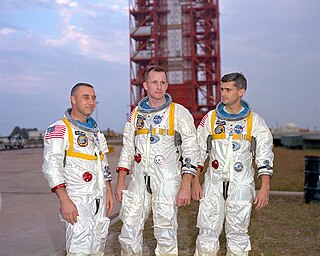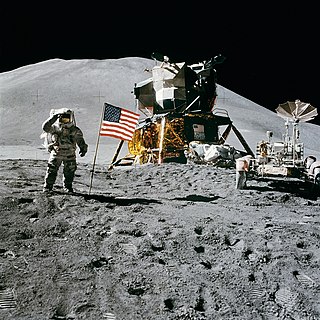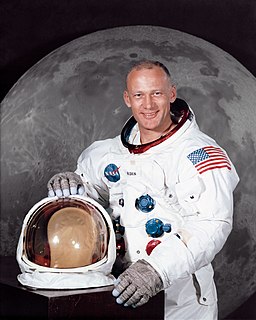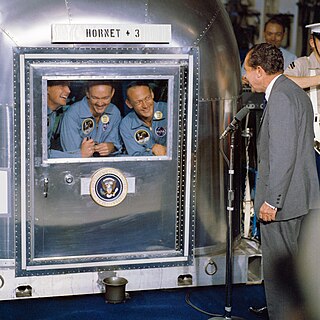
Apollo 11 was the spaceflight that first landed humans on the Moon. Commander Neil Armstrong and lunar module pilot Buzz Aldrin formed the American crew that landed the Apollo Lunar Module Eagle on July 20, 1969, at 20:17 UTC. Armstrong became the first person to step onto the lunar surface six hours and 39 minutes later on July 21 at 02:56 UTC; Aldrin joined him 19 minutes later. They spent about two and a quarter hours together outside the spacecraft, and they collected 47.5 pounds (21.5 kg) of lunar material to bring back to Earth. Command module pilot Michael Collins flew the Command Module Columbia alone in lunar orbit while they were on the Moon's surface. Armstrong and Aldrin spent 21 hours, 36 minutes on the lunar surface at a site they named Tranquility Base before lifting off to rejoin Columbia in lunar orbit.

Apollo 8 was the first crewed spacecraft to leave low Earth orbit and the first to reach the Moon, orbit it, and return. Its three-astronaut crew—Frank Borman, James Lovell, and William Anders—were the first humans to fly to the Moon, to witness and photograph an Earthrise, and to escape the gravity of a celestial body.

Apollo 13 was the seventh crewed mission in the Apollo space program and the third meant to land on the Moon. The craft was launched from Kennedy Space Center (KSC) on April 11, 1970, but the lunar landing was aborted after an oxygen tank in the service module (SM) failed two days into the mission. The crew instead looped around the Moon, and returned safely to Earth on April 17, 1970. The mission was commanded by Jim Lovell with Jack Swigert as command module pilot and Fred Haise as lunar module pilot. Swigert was a late replacement for Ken Mattingly, who was grounded after exposure to rubella.

Apollo 7 was an October 1968 human spaceflight mission carried out by the United States. It was the first mission in the United States' Apollo program to carry a crew into space. It was also the first U.S. spaceflight to carry astronauts since the flight of Gemini XII in November 1966. The AS-204 mission, also known as "Apollo 1", was intended to be the first crewed flight of the Apollo program. It was scheduled to launch in February 1967, but a fire in the cabin during a January 1967 test killed the crew. Crewed flights were then suspended for 21 months, while the cause of the accident was investigated and improvements made to the spacecraft and safety procedures, and uncrewed test flights of the Saturn V rocket and Apollo Lunar Module were made. Apollo 7 fulfilled Apollo 1's mission of testing the Apollo command and service module (CSM) in low Earth orbit.

Apollo 9 was a March 1969 human spaceflight, the third in NASA's Apollo program. Flown in low Earth orbit, it was the second crewed Apollo mission that the United States launched via a Saturn V rocket, and was the first flight of the full Apollo spacecraft: the command and service module (CSM) with the Lunar Module (LM). The mission was flown to qualify the LM for lunar orbit operations in preparation for the first Moon landing by demonstrating its descent and ascent propulsion systems, showing that its crew could fly it independently, then rendezvous and dock with the CSM again, as would be required for the first crewed lunar landing. Other objectives of the flight included firing the LM descent engine to propel the spacecraft stack as a backup mode, and use of the Portable Life Support System backpack outside of the LM cabin.

Apollo 1, initially designated AS-204, was the first crewed mission of the United States Apollo program, the undertaking to land the first men on the Moon. Planned as the first low Earth orbital test of the Apollo command and service module, to launch on February 21, 1967, the mission never flew; a cabin fire during a launch rehearsal test at Cape Kennedy Air Force Station Launch Complex 34 on January 27 killed all three crew members—Command Pilot Virgil I. "Gus" Grissom, Senior Pilot Ed White, and Pilot Roger B. Chaffee—and destroyed the command module (CM). The name Apollo 1, chosen by the crew, was made official by NASA in their honor after the fire.

Apollo 12 was the sixth crewed flight in the United States Apollo program and the second to land on the Moon. It was launched on November 14, 1969, from the Kennedy Space Center, Florida, four months after Apollo 11. Commander Charles "Pete" Conrad and Apollo Lunar Module Pilot Alan L. Bean performed just over one day and seven hours of lunar surface activity while Command Module Pilot Richard F. Gordon remained in lunar orbit. The landing site for the mission was located in the southeastern portion of the Ocean of Storms.

Apollo 15 was the ninth crewed mission in the United States' Apollo program, and the fourth to land on the Moon. It was the first J mission, with a longer stay on the Moon and a greater focus on science than earlier landings. Apollo 15 saw the first use of the Lunar Roving Vehicle.

Virgil Ivan "Gus" Grissom was one of the seven original National Aeronautics and Space Administration's Project Mercury astronauts, and the first of the Mercury Seven to die. He was also a Project Gemini and an Apollo program astronaut. Grissom was the second American to fly in space, and the first member of the NASA Astronaut Corps to fly in space twice. In addition, Grissom was a World War II and Korean War veteran, U.S. Air Force test pilot, and a mechanical engineer. He was a recipient of the Distinguished Flying Cross, and the Air Medal with an oak leaf cluster, a two-time recipient of the NASA Distinguished Service Medal, and, posthumously, the Congressional Space Medal of Honor.

Buzz Aldrin is an American engineer and a former astronaut and fighter pilot. Aldrin made three spacewalks as pilot of the 1966 Gemini 12 mission, and as the Apollo Lunar Module pilot on the 1969 Apollo 11 mission, he and mission commander Neil Armstrong were the first two humans to land on the Moon.

The Space Race was a 20th-century competition between two Cold War rivals, the Soviet Union (USSR) and the United States (US), to achieve firsts in spaceflight capability. It had its origins in the ballistic missile-based nuclear arms race between the two nations that occurred following World War II. The technological advantage required to rapidly achieve spaceflight milestones was seen as necessary for national security, and mixed with the symbolism and ideology of the time. The Space Race led to pioneering efforts to launch artificial satellites, uncrewed space probes of the Moon, Venus, and Mars, and human spaceflight in low Earth orbit and to the Moon.

Michael Collins is an American former astronaut who flew the Apollo 11 command module Columbia around the Moon while his crewmates, Neil Armstrong and Buzz Aldrin, made the first crewed landing on the surface. He was a test pilot and major general in the US Air Force Reserves.

The Apollo Lunar Module, or simply lunar module, originally designated the Lunar Excursion Module (LEM), was the lander spacecraft that was flown from lunar orbit to the Moon's surface during the U.S. Apollo program. It was the first crewed spacecraft to operate exclusively in the airless vacuum of space, and remains the only crewed vehicle to land anywhere beyond Earth.

Cosmosphere is a space museum and STEM education center in Hutchinson, Kansas, United States. It was previously known as the Kansas Cosmosphere. The museum houses over 13,000 spaceflight artifacts - the largest combined collection of US and Russian spaceflight artifacts in the world, and is home to internationally acclaimed educational programs.

Thomas Kenneth Mattingly II, is a former American naval officer and aviator, aeronautical engineer, test pilot, Rear Admiral in the United States Navy and astronaut who flew on the Apollo 16, STS-4 and STS-51-C missions.

Alfred Merrill "Al" Worden, , is an American astronaut and engineer who was the Command Module Pilot for the Apollo 15 lunar mission in 1971. One of only 24 people to have flown to the Moon, he orbited it 74 times in the Command Module Endeavour.

Project Gemini was NASA's second human spaceflight program. Conducted between projects Mercury and Apollo, Gemini started in 1961 and concluded in 1966. The Gemini spacecraft carried a two-astronaut crew. Ten Gemini crews flew low Earth orbit (LEO) missions during 1965 and 1966, putting the United States in the lead during the Cold War Space Race against the Soviet Union.

The mobile quarantine facility (MQF) is a converted Airstream trailer used by NASA to quarantine astronauts returning from Apollo lunar missions for the first few days after splashdown. The MQF was on the aircraft carrier that picked up the capsule. Once the aircraft carrier reached port, the MQF was flown to Houston, and the crew served the remainder of the 21 days of quarantine in the Lunar Receiving Laboratory at the Manned Spacecraft Center. The purpose of the quarantine was to prevent the spread of any contagions from the Moon, though the existence of such contagions was considered unlikely. It functioned by maintaining a lower pressure inside and filtering any air vented.





















